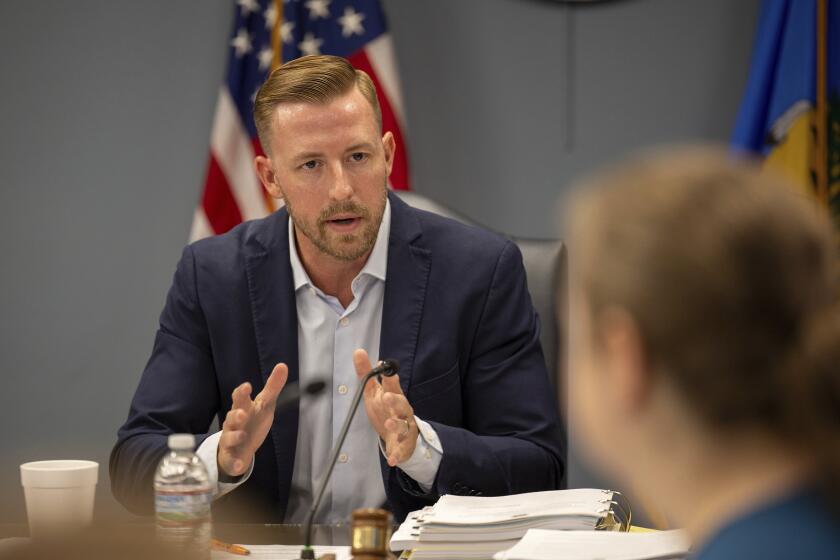Wrangling Over School Dollars : Education: Elementary principals are tired of seeing their secondary counterparts get more money per pupil and want a more equal distribution of funds.
For years, elementary principals in the San Diego city schools have chafed at the district policy of giving more funds to secondary schools than to their campuses.
Spending on elementary students averages $2,491 per child across 106 schools, contrasted with $3,113 per pupil across 40 junior- and senior-high schools.
The resentment is illustrated by the story of a principals’ meeting a couple of years ago to discuss inequities. The talk had turned to “extended day units,” money given only to high schools to pay coaches for after-school sports work.
“I think we ought to have some of those,” an elementary principal said, turning to University City High Principal Mary McNaughton.
“But what would you do with them?” McNaughton replied, puzzled over why a primary school would need funds for interscholastic athletics.
“Well, tell me what are these funds for?” her elementary counterpart queried, clearly unfamiliar with the term.
The conversation sums up the prevailing view today of most elementary principals in the 124,000-student district, the nation’s eighth-largest urban system:
They may not always know why their secondary colleagues get more money, but they know that their colleagues do, and now they want some of it.
During the past year, their determination to change spending patterns has grown bolder, bolstered by national research that shows the early elementary years may be the most important time to establish students’ academic success.
And, as the regular school year starts Tuesday, debate over funding allocations has become more shrill, resulting in a decision this summer by secondary principals to form their own interest group, separate from elementary principals, to lobby top district administrators and the school board.
“We’ve got to be much more passionate about arguing that the middle and senior-high schools have just as great a need for their funds as do elementaries,” said Joene Bruhn, principal at Bell Junior High.
The split came to a head during heated debates this past spring over how to cut more than $30 million from the school budget.
First, an advisory committee of mostly elementary teachers called in March for a 62% cut in secondary sports budgets--in effect killing all competitive sports--as a way to protect more elementary academic programs. The suggestion, which died at the board level, enraged high-school coaches and principals, as well as parents, who see such sports as a major reason why some students stay in school.
Then in May, elementary principals, through their organized network, asked schools Supt. Tom Payzant to change the funding system.
Their letter asked him to create a single kindergarten through 12th-grade allocation formula--based on enrollments--for determining the number of vice principals, counselors, librarians, secretaries and other services at an individual school.
The district now uses one set of formulas for grades K-6 and a second, generally more generous set, for grades 7-12.
Payzant decided in May not to take the request to the school board because of a lack of time to study the implications. Almost all of the budget cuts for this year were made proportionately between the elementary and secondary levels.
But the elementary schools seem to have a winning edge. In an interview last week, Payzant said that the elementary principals “make a strong case” that they have been deprived for years.
“And we do know that, in terms of a long-run payoff, it makes sense to invest more in the early (K-3) years to get better results for students in their later years . . . and traditionally, secondary schools are more costly to run.”
But Payzant said principals “cannot afford a lot of internal bickering and division if they want to make a case to the public” for more money.
“Such bickering will only reinforce the notion that bureaucracies don’t work in the interests of children.”
Passions are running high over the issue, especially because another lean budget year is forecast for 1992-93.
“I’ve got more than 800 students and one vice principal and one counselor 3 1/2 days a week,” said Hage Elementary principal Grace Sherr, who heads the Elementary Administrators Network. “By comparison, Kroc Junior High has less than 800 students, but has two vice principals, a librarian and two full-time counselors.
“We aren’t saying to take away money now from secondary, but we are saying that any further budget cuts should be made from secondary (schools) only” and that any new money should go to the elementaries.
“The question for us is whether we sit back and wait for new dollars to come from the state, or do we lobby now and ask for a reshuffling of resources?” asked Carol Pike, Hancock Elementary principal who wrote the May memo.
“For 17 years, I’ve heard the rhetoric about doing more at the early (grades) because research says that earlier intervention,” such as smaller class size, more attention to students and better health services, will mean fewer dropouts and drug problems later, she said.
“If we just keep saying, ‘Yes, that’s right, but we don’t have additional money, and we don’t want to upset the secondary people,’ then how will we ever know that we can work better for students?”
The new principal at Kroc, Barbara Coates, comes from several years as principal of Bay Park Elementary.
“It’s true that many secondary people feel that little bodies mean little problems,” Coates said. “And those formulas are based on a time when all elementary kids came from stable homes, and you didn’t have first-graders as foul-mouthed as truck drivers.
“But to take away money from secondary, that is a hard thing psychologically for us.”
In the view of many secondary principals, the elementary schools’ argument is based on a false premise that problems can be treated equally at the two levels, or that less money wouldn’t affect their work with students already at their schools with reading problems, or gang affiliations, or infant children--all of whom need extra help.
“Working with 1,200 kids at an elementary school is just totally different than working with the same number at the high school,” Principal Mike Lorch of Kearny High said.
“After having been at an elementary school this summer, I can tell you it’s a cakewalk compared to secondary. You have little kids who are more receptive to you--you even have (teachers) who are easier to work with--they’re not academic subject specialists and therefore they’re more (in tune) to the entire school atmosphere.”
Lorch said neither elementary principals nor most district administrators appreciate the differences.
“They don’t know what it’s like to stand in the middle of a high-school parking lot after a (night) football game you’ve lost and fear for your life,” Lorch said, “because kids have been throwing colors down (flashing gang signs) in the bleachers, and now you think about whether there will be a drive-by shooting.
“A third-grader being a gang member wanna-be is a different person than one at the 11th or 12th grade who brings a .357 magnum and is selling dope.”
Florence Johnson oversees 4th- through 12th-graders at the School for Creative and Performing Arts, a magnet school.
“It’s unacceptable to take away from secondary because there are problems unique to that level,” Johnson said. “What is the point in robbing Peter to pay Paul? I’ve only got one person now in my tutoring center for all the students who need help.
“And I don’t know of any parent who thinks it is easier to control your 17-year-old when he acts out than your 11-year-old.”
McNaughton of University City High said further cutbacks would affect her academic offerings.
“I offer two advanced-placement chemistry classes now because I’ve got 40 kids wanting the course,” she said. “So I run two sections with 20 kids because it’s unfair to them to run one with 40 crammed in. If you take money away, and that means (taking away) teachers, is that fair?”
The secondary principals want their new lobbying group to talk regularly with school board members and district administrators.
“We don’t want any more surprises,” Mission Bay Principal Maruta Gardner said. “Our ideas have not been communicated well. . . . there’s only a few of us (compared to numbers of elementary principals) and we need to have our voice heard more consistently.”
Board member John De Beck agreed that the secondary principals “need to band together with a common voice.”
But the elementaries’ argument, especially for an expanded K-3 curriculum, has merit, he said.
“If parents came and said they were more concerned about the elementary level than about football, for example, then I could see taking a bite out of the budget elsewhere,” he said.
Colleague Sue Braun is more emphatic. “While I know that secondary people see themselves losing power, I still feel” that we need to put more money into the primary grades, “even if that means less for the high schools.”
“If kids were in better shape when they left elementary school, then we wouldn’t have to spend so much later.”
More to Read
Sign up for Essential California
The most important California stories and recommendations in your inbox every morning.
You may occasionally receive promotional content from the Los Angeles Times.










